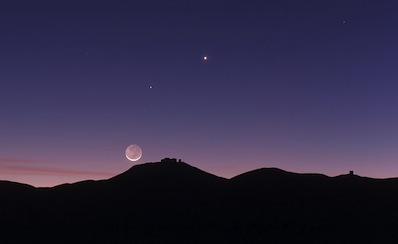
Earthshine used to test life detection method
DR EMILY BALDWIN
ASTRONOMY NOW
Posted: 29 February 2012


By imagining the Earth as an exoplanet, scientists observing our planet's reflected light on the Moon with ESO's Very Large Telescope have demonstrated a way to detect life on other worlds.
“The Sun shines on the Earth and this light is reflected back to the surface of the Moon,” explains ESO's Michael Sterzik, lead author of the paper featured in the 1 March issue of the journal Nature. “The lunar surface acts as a giant mirror and reflects the Earth’s light back to us – and this is what we have observed with the VLT.”

This view shows the thin crescent Moon setting over ESO’s Paranal Observatory in Chile, home of the VLT. As well as the bright crescent the rest of the disc of the Moon can be seen as earthshine. By observing this light, which is sunlight reflected off the Earth, astronomers can study the Earth as if it were an exoplanet and search for signs of life. Mercury and Venus are also seen in this image, taken on 27 October 2011. Image: ESO/B. Tafreshi/TWAN.
Earth's reflected light onto the Moon – earthshine – can easily be seen with the naked eye when the Moon appears as a thin crescent in the night sky. As well as the bright crescent, the full disc of the Moon is also visible, dimly lit by Earth's light.
The team looked at the polarisation of the reflected light to demonstrate how a planet that hosts life would look when observed from space. They conclude that Earth's atmosphere is partly cloudy, has oceans and that there is vegetation. Changes in cloud cover and amount of vegetation could also be deduced as different parts of the Earth reflected light towards the Moon.
“The light from a distant exoplanet is overwhelmed by the glare of the host star, so
it’s very difficult to analyse – a bit like trying to study a grain of dust beside a powerful light bulb,” says co-author Stefano Bagnulo from Armagh Observatory, Northern Ireland. “But the light reflected by a planet is polarised [i.e. it oscillates in a specific direction], while the light from the host star is not. So polarimetric techniques help us to pick out the faint reflected light of an exoplanet from the dazzling starlight.”
The work marks an important step in the ability to detect signs of life elsewhere in the Universe, but there is a long road ahead before ground-based telescopes have the sensitivity to pick out the finest details of a distant world.
"Current instruments, including the forthcoming SPHERE instrument of the VLT may allow a rough characterisation of the atmosphere of a large exoplanet in close orbit around its star," Bagnulo tells Astronomy Now. "Only the E-ELT (European Extremely Large Telescope), with its collecting area more than 20 times larger than that of the VLT, will permit a more refined characterisation of the surfaces and atmospheres of the planets. However, for an Earth-like planet, the detection of the fine structure presented in our paper, and in particular oxygen and vegetation features, will be extremely difficult even with the E-ELT."
|



